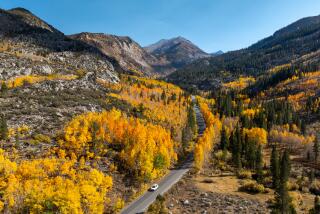GARDENING : The Colorful Story of Autumn
- Share via
There’s more to fall foliage than meets the eye. Here’s the story behind leaves’ colorful change from Stanley Krugman, a geneticist for the U.S. Forest Service:
* Longer nights are the primary cause of hue change. But other conditions also can affect fall foliage. Limited rainfall, for example, can dull color brilliance, and frost can shorten color duration.
* Diminished daylight can’t sustain chlorophyll, which is the pigment that gives leaves their green shade, so chlorophyll diminishes. Its decline allows other pigments to shine through, bringing out the yellow, orange, red and brown tones.
* Genetics determines how quickly leaves change. Some, such as the ginkgo, can change overnight, but others, such as the oak, require a week.
* Different species show their fall colors at different times. For example, aspens are among the first trees to turn. The change generally occurs in late August and September in northern areas to late October and November in southern regions.
* Fall foliage appears all over the United States--including Southern California.






